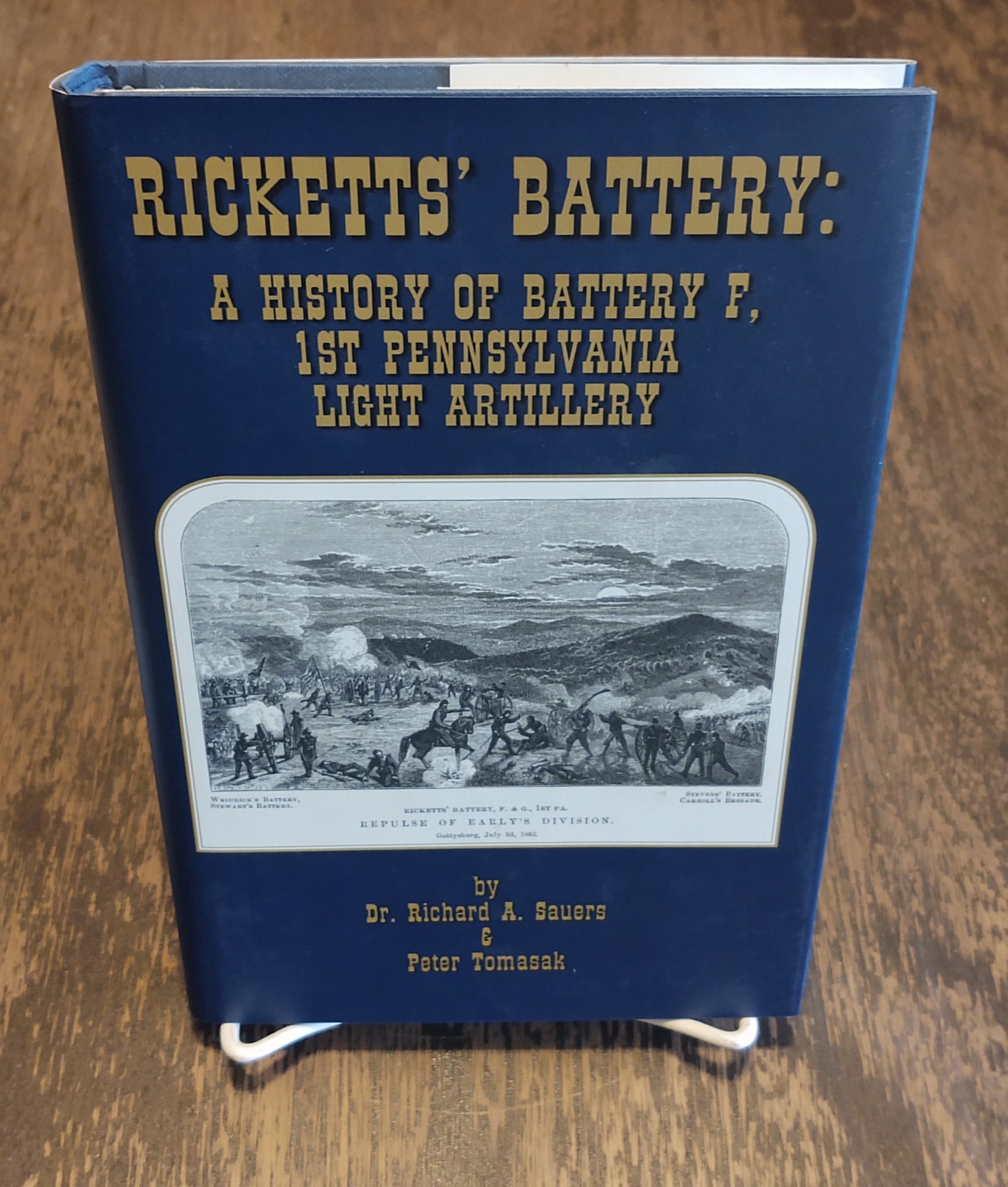Ricketts’ Battery
A History of Battery F,
1st Pennsylvania Light Artillery
—————————————–
2001
(First Edition)
==========================================
Condition : Hardcover – Fine, unused / new condition.
New “old stock” – book is like new, but DJ has light wear.
(purchased from a distributor who was downsizing retail space)
==========================================
288 pages, over 50 portraits / illustration / maps
—–
A Modern Regimental History, not a reprint.
Dornbush lists no original works on Battery F.
(not to be confused with the Hampton Battery – Battery F, Independent PA Arty)
From Wikipedia Entry for Battery F, 1st Pennsylvania Artillery
Early Civil War : The First Pennsylvania Light Artillery (otherwise known as the 43rd Regiment Pennsylvania Volunteers) was organized in 1861. The regiment left for Washington, D.C. in August of that year. Battery F was formed under Capt. Ezra W. Matthews. Bruce Ricketts joined the service on July 8, as a private of that year, and he was commissioned as first lieutenant in that battery about a month later. The regiment was split up, with individual batteries serving with different divisions of the Army of the Potomac. Battery F first saw combat at the Battle of Dranesville on December 20, 1861. Ricketts’ section had one gun disabled in that action. Later the section served in the defense of Hancock, Maryland, against a foray by Stonewall Jackson.
Battery F served in the Army of Virginia in the corps of Major General Irwin McDowell, joining it on March 21, 1862, at Warrenton, Virginia. In that context it was involved, under Ricketts’ leadership, in a reconnaissance expedition to Rappahannock Station, Virginia, that left on April 7, of that year. This force advanced and then withdrew, having accomplished its information-gathering purpose. Thereafter the battery was involved in the campaign culminating in the Second Battle of Bull Run. Battery F was seriously engaged in the Battle of Cedar Mountain on August 8, helping McDowell cover the retreat of the corps of Major General Nathaniel Banks. The battery helped defend Henry House Hill at Second Bull Run, and it was present at the Battle of Chantilly though not engaged. It also participated in the “artillery hell” of the Battle of Antietam. Lt. Ricketts missed most of these actions while serving on recruiting duty. He returned to the Army of the Potomac on September 23, 1862.
Ricketts commanded Battery F, First Pennsylvania Light Artillery from then on until the summer of 1864. Capt. Matthews went down ill and did not return to battery command. Ricketts was engaged with his guns at the Battle of Fredericksburg, serving with second division I Corps under Major General John F. Reynolds. When Capt. Matthews was promoted to the rank of major, Ricketts became a captain on March 14, 1863. At the Battle of Chancellorsville Ricketts’ battery was with Major General Abner Doubleday’s third division I Corps.
Gettysburg
Ricketts’ battery was – beginning on May 13, 1863 – in the third volunteer brigade of the Reserve Artillery under Capt. James F. Huntington. Battery G, First Pennsylvania Light Artillery, was attached to Ricketts’ battery a few weeks before the Battle of Gettysburg, on June 1, 1863. This merger was resented until gunners from Battery G were permitted to form a section of the consolidated battery. This merger took place while the army was marching north in pursuit of the Army of Northern Virginia, beginning on May 15.
Ricketts’ battery arrived in Gettysburg on the Taneytown Road on the morning of July 2, 1863, and replaced Capt. James H. Cooper’s Battery B, First Pennsylvania Light Artillery, on East Cemetery Hill about 4:00 PM. It was exposed to enfilade fire from Benner’s Hill and Seminary Ridge. Around nightfall, two Confederate brigades from the division of Major General Jubal Early attacked the hill. It broke the thin Union front line at the foot of the hill in two places. In other places they were repelled. Some Confederates reached the top of the hill, and one group attacked the left of Ricketts’ battery, trying to spike the guns. The fight for the guns became hand to hand, but the Confederates were unable to capture the whole battery. Eventually Union reinforcements from the II Corps brigade of Col. Samuel S. Carroll drove the Confederates down hill. A monument to the battery stands in the general location of their fight.
After the battle, Ricketts criticized Adelbert Ames’ division of XI Corps, although he probably could not see what was going on down there at the foot of the hill. He thought they fled unnecessarily. Ricketts’ account of the action makes it look as if his battery stood alone for an extended time. However, a less colorful account by a modern historian shows that some of the XI Corps troops had rallied and stood fast atop Cemetery Hill even before reinforcements from Col. Carroll’s brigade of II Corps came up behind Ricketts’ position.
The report that a Confederate veteran looked at Ricketts, a slight man, and commented, “And did this little cuss command Battery Hell!,” may be apocryphal.


